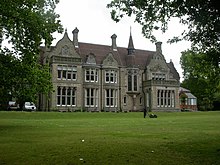Robert Scott (businessman, born 1822)
Robert Scott (1822 – 2 February 1904[1]) was a Manchester businessman who was one of the founders of the Tootal Broadhurst Lee cotton company.[2]
Scott was a notable early example of a successful manager in the textile industry, achieving significant wealth within the largest company of the time whilst being neither self-made nor from a textile family. [3] Born the son of a farmer at Abbey Holm in Cumbria, he was a salesman by the time of his 1845 marriage to Maria in Cheetham Hill, north Manchester. [2] He became a business partner of Henry Tootal Broadhurst, Henry Lee and Joseph Lee who together subsequently formed the company Tootal Broadhurst Lee, a vertically integrated firm that was unusual for its time in combining weaving and spinning [4] and was to become by the 1880s the largest cotton manufacturer in Lancashire.[5] Henry Tootal Broadhurst's son, Edward Tootal Broadhurst would go on to become company chairman. Scott became 'cashier', or finance director, of Tootal Broadhurst Lee in 1854 [3] and was deputy chairman of the Equitable Fire and Accident Office insurance company;[6] by the 1881 census he was described a spinning manufacturer.[3]

In 1874 Scott bought ten acres of land in Bowdon, south Manchester, from the Earl of Stamford at a cost of £7075[3] and built a large villa, Denzell,[7] to the designs of the architects Clegg and Knowles.[8] The house cost £18,000[2] to build and a reported £30,000 in all. [9] Scott was recorded in the 1881 census as living at Denzell with his wife and a staff of nine.[2] The building is now known as Denzell Hall and is Grade II* listed as a notable example of a specifically commissioned late nineteenth century house for a wealthy patron with a high degree of craftsmanship and quality of materials.[8] The listing cites the design as inventive and eclectic and by a noted Manchester architects' practice; [8] the architectural critic Pevsner described it as a luscious but 'very bad' mixture of debased Jacobean, Gothic and Italianate. [10] Scott's son Henry predeceased him and at his death in 1904 the house was sold to the Lamb family. [9]
References
- ^ "Re Robert Scott, Deceased" (PDF). The London Gazette (27657): 1718. 15 March 1904. Retrieved 20 March 2016.
- ^ a b c d Marjorie Cox (October 1986). "Denzell Owners & Occupiers" (PDF). Bowdon Sheaf. 20. Bowdon History Society: 3–4. Retrieved 20 March 2016.
- ^ a b c d Bamford, Frank (1991). Mansions and Men of Dunham Massey. Altrincham: Frank Bamford. ISBN 0-9517225-0-6.
- ^ "Broadhurst, Sir Edward Tootal". Oxford Dictionary of National Biography (online ed.). Oxford University Press. doi:10.1093/ref:odnb/46780. (Subscription or UK public library membership required.)
- ^ The Lancashire Cotton Industry. 1996. ISBN 187123638X.
- ^ "The Equitable Fire and Accident Office, limited". The Times. No. 33272. London. 14 March 1891. col 3, p. 3.
- ^ Valerie Trenbath (April 1986). "Denzell" (PDF). Bowdon Sheaf. 7. Bowdon History Society: 7–8. ISSN 0265-816X. Retrieved 20 March 2016.
- ^ a b c "English Heritage listing criteria for Denzell Hall".
- ^ a b A. H. N. (3 April 1959). "Mansion that became a home of healing". Altrincham, Hale and Bowdon Guardian. p. 10.
- ^ Pevsner, Nikolaus (March 1971). Cheshire. ISBN 0300095880.
